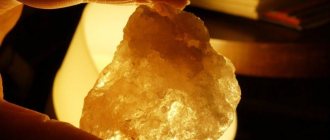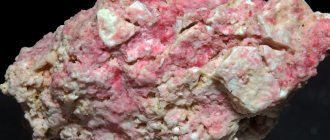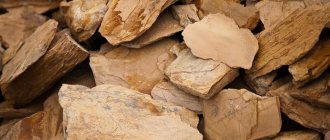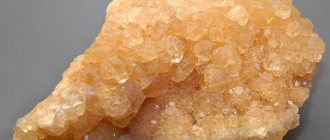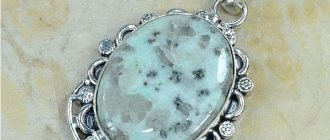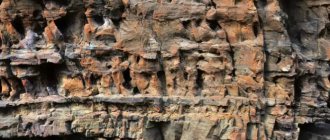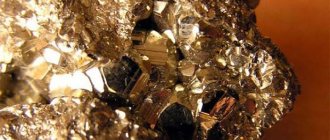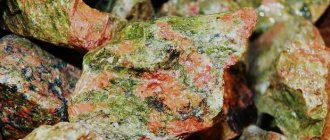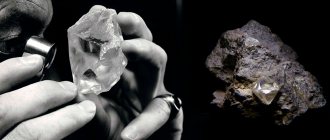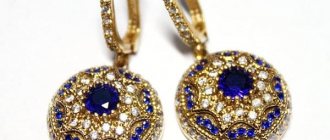Magnesite is a fairly common mineral. This is an excellent raw material for the production of magnesium and is widely used in industry for the production of refractory materials. The mineral is not used so often in jewelry.
Externally, magnesite resembles marble, but sometimes transparent, shiny crystals with light shades of yellow, brown or transparent are found. It is these nuggets that are of interest to those who like rare jewelry made from natural gems.
Physicochemical characteristics
Magnesite is a natural magnesium carbonate, which in its pure form is white or gray in color, but due to impurities it can differ in shades of yellow, brown or greenish with a characteristic matte or glassy sheen. Stone crystals are characterized by increased density and different grain sizes.
The mineral is brittle and heat sensitive, making it difficult to process. Its hardness on the Mohs scale is 3.5-4.5 units. An exception is porcelain-like magnesite, the hardness of which reaches 7 units.
Chemical composition of MgCO3: magnesium oxide - 47.82%, carbon dioxide - 52.18%, impurities of iron, magnesium and calcium.
Magnesite has perfect cleavage and an uneven conchoidal fracture. When exposed to high temperatures, it does not melt, but becomes covered with cracks. The mineral has a fluorescent effect ranging from pale green to pale blue.
CONTENT
- 1 Incident
- 2 Isotopic structure: clumped isotope 2.1 Measurements and reporting 2.1.1 Digestion, analysis and acid fractionation adjustment
- 2.1.2 Standards
- 2.1.3 Δ 47 - Temperature calibration
- 2.1.4 Fractionation coefficients of magnesite-water and CO 2 -magnesite isotopes
- 3.1 Conversion of hydrous magnesium carbonates to magnesite
- 4.1 Information from isotopic structure
- 5.1 Occupational Health and Safety 5.1.1 USA
Varieties of magnesite
Depending on the chemical elements it contains, magnesite is divided into the following varieties:
- Messitite spar is a mineral in which the proportion of magnesium is 50-70%, and iron - 50-30%, respectively.
- Brainnerite is a type of rock containing 70-90% magnesium and 30-10% iron in its composition, respectively.
- Ferrous magnesite is a brown stone in which the amount of iron exceeds 50%.
- Nickel magnesite is a mineral that contains an admixture of nickel.
- Helmagnesite is an amorphous variety that does not have a crystal lattice.
Place of Birth
Magnesite is mined in Russia, Greece, USA, India, Mexico, China, Austria and Australia.
The Savinskoye field, located in the Irkutsk region of Russia, is recognized as the largest in the world. Large magnesite deposits have also been discovered in the Southern Urals. The Satkinskoe deposit in the Chelyabinsk region is famous for the astrakhan mineral, distinguished by its decorative appearance due to tree-like inclusions. Industrial magnesite is mined in the Far East and in the middle Volga region.
Bright yellow magnesite stones used in jewelry are found in Australia, and deposits of ornamental samples are mined in Canada and the USA. But Brazil is famous for the largest collectible crystals, the size of which after processing reaches 100 carats. Transparent magnesite is mined in southern India.
Origin of the mineral
This mineral received its name in honor of the Greek region of Magnasia. It was in this area that the magnesite stone was found for the first time. Magnesite deposits are of hydrothermal type and surface type. The formation of the mineral is facilitated by the replacement of calcium with magnesium in hot deep solutions. If deposits of magnesite rocks are located on the surface of the earth, then the crystals of the mineral take on a granular shape, which is facilitated by strong winds. Magnesite, which is found in the bowels of the earth, often has a crystalline form. Such samples of magnesian rocks have a higher price due to their rarity.
Magical properties of magnesite
Since ancient times, magnesite has been credited with magical properties. It is believed that it promotes the formation of a family and the happiness of two lonely hearts. He helps young people find a life partner, and divorced couples to start a happy life with another chosen one.
Magnesite helps strengthen relationships between relatives and pacify the struggle of generations. There is an opinion that if a daughter-in-law gives her mother-in-law jewelry with magnesite, then the latter will accept her into the family with maternal love. The same applies to a son-in-law who wants to win the favor of his mother-in-law.
Natural stone is a guide to the natural world. It has long been believed that with its help you can learn to communicate with birds and animals in their language. A person who constantly wears magnesite will be able to tame any animal and get a devoted friend.
It is also believed that the magnesite talisman, with its properties, is capable of awakening a hidden gift for supernatural abilities - clairvoyance, communication with the other world. Magnesite will help creative individuals develop their imagination and discover new horizons.
Medicinal properties
Magnesite can have a beneficial effect on mood and the nervous system. If you look at a yellow stone continuously for several minutes, it will help get rid of fatigue, fears and depressive moods.
In lithotherapy, magnesite is also used for:
- reducing symptoms of premenstrual syndrome in women;
- elimination of toothache, headaches, migraine attacks;
- cleansing the body of toxins;
- normalization of the gastrointestinal tract;
- preventing the onset of arthritis.
A white stone will relieve eye fatigue. To do this, you need to look at it without blinking.
Areas of application of magnesite
Due to its properties, magnesite is widely used in industry and agriculture. It is actively used in the pulp industry, in the manufacture of water purification filters, and for gas purification. The stone effectively purifies water by neutralizing and precipitating heavy metals. It is used in the refractory and petrochemical industries, as well as in the production of fertilizers.
In the field of building materials, the mineral is used to make magnesite slabs, the popularity of which is rapidly growing due to the unique properties and characteristics of the stone. They are fireproof, environmentally friendly, durable, moisture resistant, have high heat and sound insulation, and are also easy to process.
Magnesite slabs are used for finishing the facades of houses, slopes, swimming pools, saunas and garages, arranging floors and making door panels. The natural structure and color of the slabs allow you to obtain an individual finish and natural design.
Magnesite is a popular ornamental stone and collectible mineral, but it is rarely used in jewelry, with the exception of bright yellow crystals found in Central Australia and specimens brought from Brazil. Colored magnesite can easily be confused with lapis lazuli, turquoise or red coral.
Formation[edit]
Magnesite can be formed by talc carbonate metasomatism from peridotite and other ultramafic rocks. Magnesite is formed by the carbonization of olivine in the presence of water and carbon dioxide at elevated temperatures and high pressures typical of the greenschist facies.
Magnesite can also be formed by the carbonization of magnesium serpentine (lizardite) by the following reaction:
2 Mg 3 Si 2 O 5 (OH) 4 + 3 CO 2 → Mg 3 Si 4 O 10 (OH) 2 + 3 MgCO 3 + 3 H 2 O
However, when this reaction is performed in the laboratory, the trihydrated form of magnesium carbonate (nesquegonite) is formed at room temperature. [17] This observation led to the postulation of a "dehydration barrier" involved in the low-temperature formation of anhydrous magnesium carbonate. [18] Laboratory experiments with formamide, a liquid resembling water, showed that no such dehydration barrier could be involved. The fundamental difficulty of nucleating anhydrous magnesium carbonate remains when using this non-aqueous solution. It is not the dehydration of cations, but rather the spatial configuration of carbonate anions that creates a barrier to low-temperature nucleation of magnesite. [19] Precipitation of magnesite requires high pH and the absence of other cations.
Magnesite in natural form (from Ljubenik in Slovakia)
Magnesite has been found in modern sediments, caves and soils. Its low-temperature (around 40 °C [104 °F]) formation is known to require alternating intervals of precipitation and dissolution. [20] [21] [22]
Magnesite was discovered in the meteorite ALH84001 and on the planet Mars itself. Magnesite has been identified on Mars using infrared spectroscopy from satellite orbit. [23] Magnesium carbonates have been discovered near Jezero Crater and are said to have formed in the lacustrine environment that prevailed there. [24] Controversy still exists over the temperature at which these carbonates formed. Low-temperature formation of magnesite from the Martian meteorite ALH84001 has been suggested. [25][26] Low-temperature formation of magnesite may be important for large-scale carbon sequestration. [27]
Magnesium-rich olivine (forsterite) promotes the production of magnesite from peridotite. Iron-rich olivine (fayalite) contributes to the production of magnetite-magnesite-silica compositions.
Magnesite can also form by metasomatism in skarn deposits, in dolomitic limestones, associated with wollastonite, periclase and talc.
Stable at high temperature and able to withstand high pressure, magnesite has been proposed as one of the major carbonate-bearing phases in the Earth's mantle [28] and a possible carrier for deep carbon reservoirs. [29] For the same reason, it is found in metamorphosed peridotite rocks in the Central Alps, Switzerland, [30] and in high-pressure eclogite rocks from the Tien Shan, China. [31]
Magnesite can also precipitate in lakes in the presence of bacteria as hydrous magnesium carbonate or magnesite. [32] [33]
Information from isotopic structure[edit]
Clumped isotopes were used to interpret the conditions of magnesite formation and the isotopic composition of the settling liquid. Within ultramafic complexes, magnesites are found in veins and stockworks in cryptocrystalline form, and within carbonate peridotite units in crystalline form. These cryptocrystalline forms are generally susceptible to various weathering conditions and have a low formation temperature. [34] On the other hand, large magnesites give very high temperatures, indicating a hydrothermal source. It is assumed that large high-temperature magnesites are formed from fluids originating from the mantle, while cryptocrystalline ones are deposited by circulating meteoric waters that absorb carbon from the pool of dissolved inorganic carbon, soil carbon, and are subject to nonequilibrium isotope effects.
Magnesites formed in lakes and beaches are usually enriched in heavy isotopes C and O due to evaporation and degassing of CO2. This is reflected in the very low temperature obtained from the clumped isotopes. They are affected by the influence of pH, biological activity, as well as the kinetic isotope effect associated with degassing. Magnesite forms surface forms under such conditions, but is more commonly found as hydrous Mg carbonates because their precipitation is kinetically favored. In most cases, they obtain C from DIC or nearby ultramafic complexes (e.g. Altin Playa, British Columbia, Canada [35]).
On the other hand, magnesites in metamorphic rocks indicate a very high temperature of formation. The isotopic composition of the parent fluid is also a heavy metamorphic fluid. This was confirmed by derived fluid inclusion temperatures as well as conventional O isotope thermometry involving quartz-magnesite coprecipitation.
Magnesite often registers a lower temperature of agglomerated isotopes than the associated dolomite and calcite. [36] The reason may be that calcite and dolomite form earlier at higher temperature (from mantle fluids), which increases the Mg/Ca ratio in the fluid enough to precipitate magnesite. As this happens over time, the liquid cools, evolves to mix with other liquids, and when it forms magnesite, it lowers its temperature. Thus, the presence of associated carbonates affects the isotopic composition of magnesite.
The origin of Martian carbonates can be deconvoluted using a clumped isotope. The source of CO 2 , climatic and hydrological conditions on Mars could be estimated from these rocks. A recent study showed (using clumped isotope thermometry) that carbonates in ALH84001 indicate formation under low-temperature conditions of evaporation from groundwater and the acquisition of CO 2 from the Martian atmosphere. [37]
Jewelry with magnesite and prices
Beads made of magnesite, quartz and ceramics
Only rare bright yellow stones from deposits in Brazil and Australia are used in jewelry. They are cut and polished, and then inserted into a gold frame.
Inexpensive jewelry is made from magnesite. In pendants, bracelets, earrings and rings it is set in silver.
Magnesite products have an affordable price. For example, a silver bracelet with stones costs around $25. A decorative egg, depending on the size and deposit of the stone, can be purchased for $70-110. The cost of tumbling small-sized magnesite ranges from $3 to $5.
Talismans and amulets
Magnesite can act as a talisman or amulet, protecting its owner and giving him strength to overcome dangers. The talisman is recommended to be carried with them at all times by people whose lives involve traveling - travelers, drivers and sailors. The stone also protects its owner from lurking dangers in the form of natural disasters and violent acts.
Amulets made of magnesite are placed around the neck of a child so that he finds peace and becomes obedient.
How to distinguish a fake?
The mineral is mainly used for making jewelry, which has no value in jewelry. The exception is varieties of magnesite in the form of precious crystals. Sometimes imitation red coral, turquoise and lapis lazuli are made from the mineral by dyeing.
For example, turquoise was imitated from magnesite; in order to distinguish the original from the fake on your own, this requires a microscope. There are recommendations that will help you avoid the trap of scammers.
It is better to buy natural stones in specialized stores. To ensure the originality of the mineral, a certificate is requested to prove the authenticity of the gem.
